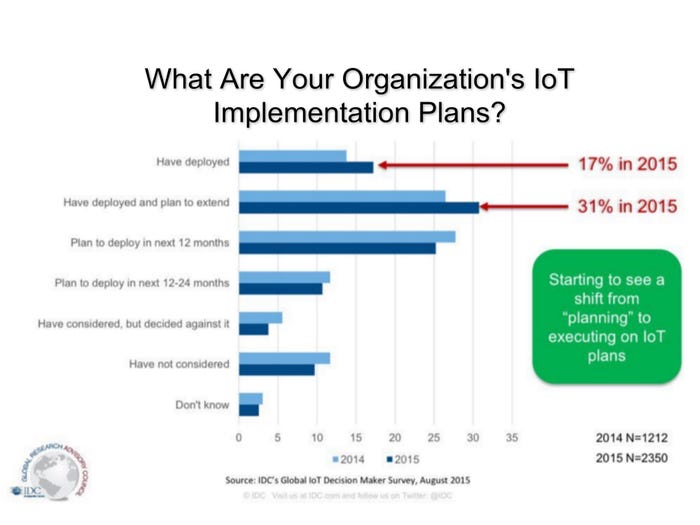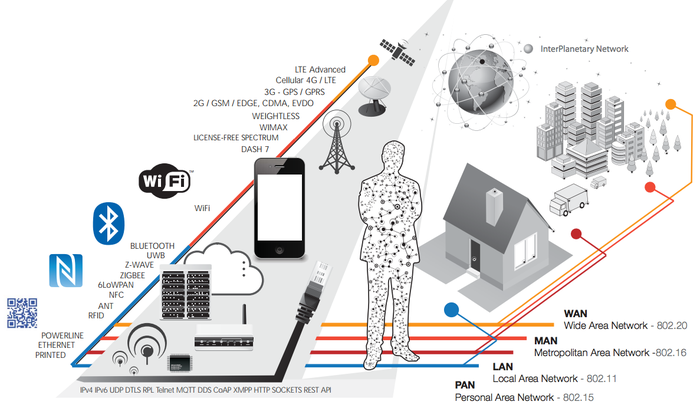5 Keys to Successful IoT Infrastructures
Before businesses can reap benefits from IoT, IT leaders must create a solid technical foundation.
February 25, 2016

The Internet of Things may be among today’s most hyped technologies, but that’s not stopping some large enterprises from seeing positive results from early implementations. One example is Avnet, the $27.9 billion technology distributor that launched IoT in its global data center to better manage ambient temperatures and energy consumption. The combination of sensors and software continuously monitors temperatures and adjusts thermostats when necessary to stay within preset thresholds.
“When we had a less accurate monitoring capability, we would err on the side of caution by over-cooling the data center,” says Steve Phillips, chief information officer. “We now consume less energy and, in turn, pay less for cooling the data center than we did in the past.”
Closer energy monitoring, along with new generations of energy-efficient IT equipment, helped Avnet avoid the $8 million in capital investments it had been contemplating to upgrade its power capacity, Phillips adds.

IDCimplementation.jpg
Avnet isn’t the only enterprise taking the IoT plunge. IDC estimates that revenue in the sector could jump to $1.7 trillion in 2020 from $656 billion in 2014. But before these megagrowth trends materialize, IT planners must face a stark reality: Flashy new applications can’t deliver quantifiable business benefits unless enterprises first create a reliable, secure IT infrastructure to support hundreds or thousands of IoT endpoints and the tide of data they generate. That means embracing new IT architectures and, in some cases, investments in either cloud or on-premises enhancements to networking, computing, storage, and analytics resources.
Fortunately, IT managers have greater choices than ever when selecting and implementing foundational technology tailored for IoT. The following five fundamental considerations can help promote IoT success.
1. IoT Architectures
There isn’t a one-size-fits-all design template for IoT, and that’s good news. IT leaders can take advantage of three main options for their unique business needs.
The first is to simply tap into existing networking, computing, and storage resources, a choice Avnet was able to make after it installed numerous sensors to collect temperature data. “Handling network traffic isn’t a challenge when it’s within the data center,” Avnet’s Phillips says.

To learn more about IoT and its impact on IT, attend the Internet of Things Summit at Interop Las Vegas this spring. Don't miss out! Register now for Interop, May 2-6, and receive $200 off.
IoT implementations that send high-volume data streams over greater physical distances may benefit from a second architectural approach, known as edge computing. With this strategy, designers enable information processing near where data is being collected, often with the help of intelligent gateways. These devices perform initial filtering and analyses that separate actionable information from raw data feeds and then send higher-value results to central applications and databases. The result is less network traffic and more efficient use of storage capacities, says Peter Christy, research director at 451 Research.
But edge computing alone isn’t always practical, creating a need in some cases for a third architectural approach: public cloud or a hybrid of private and public cloud implementations. For example, clouds enable “data lakes,” off-site data stores paired with advanced analytics applications that glean detailed insights from information. “Some analytics algorithms are too resource-intensive to run at the edge and instead need server and storage space in a data center,” says Alex Glaser, a director at Harbor Research.
Choosing an architectural design isn’t purely a technology consideration and should be driven by an organization’s business needs. “There isn’t a black-and-white answer,” Christy says. “Any of the approaches may be appropriate, depending on the application.”
2. Flexible and Reliable Networks
Architectural choices will help determine the volume of IoT traffic and how far it needs to travel for subsequent processing. From there, IT managers can choose the right mix of networking capabilities.
Wireline networks are pervasive and offer a secure, ready-to-use option for industrial IoT applications running in data centers, shop floors, and warehouses. “If you have an industrial plant with a wired connection to your corporate network, that’s a great way to go,” Christy says.
Similarly, existing enterprise WiFi networks may reliably support some IoT implementations.
But the longer-transmission ranges of some IoT applications, as well as battery-consumption considerations for endpoint devices, are pushing planners to consider additional options. Traditional 3G and 4G cellular technology offers extensive coverage, high data rates, and low latency, making it a solid choice for connecting dispersed industrial machinery and sensors. But cellular’s relative high cost and battery-draining “always-on” characteristics can be an IoT roadblock. “Cellular technology will typically be used where data can’t be transmitted in some other, more cost-effective way,” Christy says.
Similarly, high costs may lead IT managers to delay adoption of emerging 5G technology. “What the high-value applications are that will justify 5G investments is still an open question,” Christy says. “The answer may depend on whether there will be applications that just aren’t possible without 5G.”
IT managers sensitive to cost and battery-life concerns have alternatives to traditional cellular technology. LTE-M and 3GPP are LTE-based cellular protocols optimized for IoT applications, including those that use devices characterized by low data rates, require long battery life, and typically operate unattended. Use-cases include asset tracking and metering.
Other alternatives include SigFox or LoRa low-power wide area networks. “These technologies offer low power consumption and the ability to transmit messages over hundreds of meters,” Harbor Research’s Glaser notes.
In addition, the new WiFi HaLow standard using 802.11ah technology operates in frequency bands below one GHz and promises longer range WiFi with lower power connectivity for compatible products.
Rounding out the networking choices are personal area wireless networks, such as Bluetooth and ZigBee, and satellite communications, which serve shipping and other applications that extend beyond traditional cellular service areas.
Some IT leaders are looking to software-defined networking (SDN) to manage the various technology options. “For us, the key is flexibility and high reliability,” says Avnet’s Phillips. “We’re looking at using SDN in select areas, because we think it gives us new opportunities for handling different classes of service and traffic profiles.”

HarborNetworks.png
3. Scalable Storage
Even before adopting IoT, many enterprises have continued to see their storage volumes grow steadily each year. Avnet CIO Phillips estimates that his company has been adding about 30% more capacity annually in recent years and says that rate could accelerate with IoT. “The big discussion internally is what storage capacity to keep on-premises versus moving to the public cloud,” he adds.
Enterprises can simply contract for more storage capacity from cloud vendors as storage needs grow, although that may come with trade-offs in terms of higher latency and less control over how data is managed. The latter may be a cloud deal-breaker for sensitive information in highly regulated industries.
These trade-offs help explain why many large enterprises continue to invest in on-premises and private cloud storage, says Steve Hilton, an analyst at MachNation. “In the end, large enterprises are control freaks, and in the nascent world of IoT, they are concerned about data security and privacy,” he says. “I believe that large enterprises will continue to rely on on-premises and private cloud storage for IoT for two to three years, at least. Smaller enterprises deploying IoT solutions are more likely to use public cloud storage for IoT data.”
Some analysts believe hybrid cloud deployments may be the best options. “Organizations that need on-premises data storage because of security and compliance requirements may keep perhaps 10% to 20% of their data in-house,” Glaser says. “They will then leverage public clouds for rest of their storage needs.”
4. Custom Analytics
Similar debates about when to choose cloud over on-premises resources are swirling around analytics for IoT. MachNation forecasts that, over the long term, cloud-based analytics will be the most highly adopted option. The exceptions will be use-cases that rely on edge computing or those that require low network latency. These conditions will require IT departments to support on-premises analytics resources.
Either way, the actual analytics programs for IoT are distinguishing themselves from traditional business intelligence applications. “A host of companies are developing specialized analytics for areas such as predictive maintenance on jet engines and machinery used in manufacturing,” Christy says.
He’s also seen IoT applications that capture high-frequency sound recordings of machinery for acoustical analyses that correlate particular sounds to impending equipment failures. “You’re not going to do that with a SQL-based data warehouse,” he says.
To shift from traditional business intelligence reporting to more real-time and predictive analytics, Avnet upgraded its data warehouse environment with an in-memory database platform. “It’s more flexible, and it allows us to analyze broad sets of data without too much data preparation,” Phillips says.
He adds that being forward-looking is important when making decisions about IoT analytics. “Pick software tools that will be effective, not just for today, but for where you’ll think IoT may be in a couple years,” he says.
5. Pervasive Security
Overriding all infrastructure decisions are concerns about protecting IoT systems from unauthorized access and keeping the data they generate secure. Lingering questions about how to address these areas represent a top inhibitor to IoT growth, MachNation analyst Hilton says. “Businesses and governments invest tremendous time and money securing their traditional IT assets—PCs, desktops, servers, routers, and switches,” MachNation’s recent report on IoT security says. “It is not surprising that these same organizations are reluctant to implement new IoT solutions unless they are comfortable with the high levels of security they can provide.”
Avnet’s Phillips applies many of the same security policies and technologies used for enterprise applications to IoT systems. These range from strong password and two-factor authentication to data encryption. “Our approach is to take the trusted information security techniques we have in place and apply them to new environments, such as IoT,” he says.

To learn more about IoT and its impact on IT, attend the Internet of Things Summit at Interop Las Vegas this spring. Don't miss out! Register now for Interop, May 2-6, and receive $200 off.
About the Author
You May Also Like




